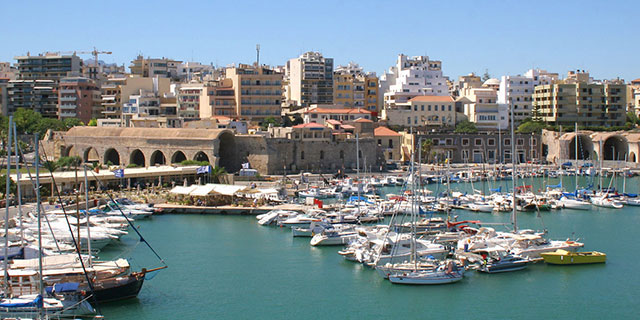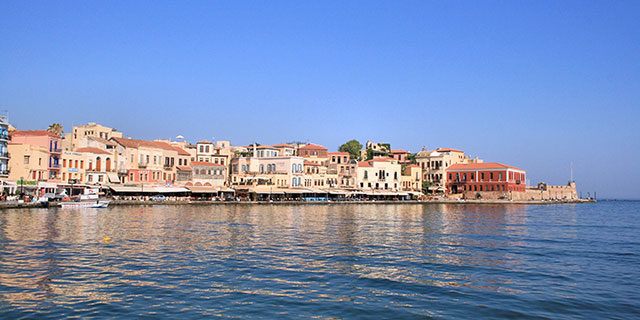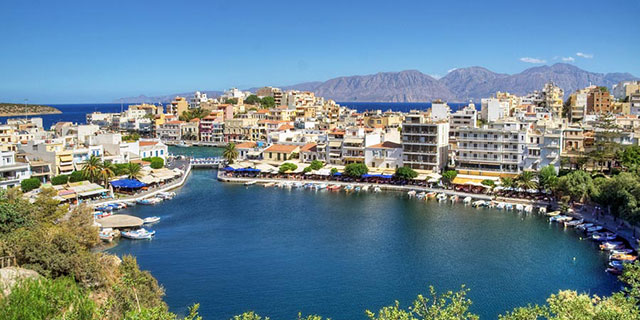It is found between three continents: Europe, Asia and Africa. It is washed North from Cretan Sea, Southern from the Libyan Sea, Westwards from Southern Ionian Sea and the Mediterranean and Eastern from Carpathian Sea. It has extent 8.338 t. km and population above 650.000 residents.

It is divided in four prefectures: Chanias with capital Chania, Rethimno with capital the Rethimno, Heraklion with capital the Heraklion and Lasithi with capital Agios Nikolaos. Crete is surrounded by small islands or islets that all are uninhabited. The only habitable island is Gavdos that is found in the southerners.
The ground of Crete is in his bigger extent mountainous. In many places it is rocky. Analytically its distribution in categories has as follows: 33% flat, 26% semi mountainous and 41% mountainous.
Three are the main mountain ranges of Crete: Lefka Ori, Idi and Dikti. Lefka Ori or Madares are found in its western department and have taller top Pachnes (2.452 m.). Idi or Psiloritis occupies the centre of the island and has taller top Timio Stavro (2.456 m.). Between Heraklion and Lasithi is raised Dikti, with taller top Entichi (2.148 m.). In utmost Eastern of the island is extended Ori of Sitia, with taller top Afenti (1.475 m.). In southern of Heraklion unfolds the low mountain range Asterousia (1.231 m.)

Two only are the plains of Crete: Chanias and Mesaras.
It has however a lot of plateaux: Armenon at Sitia, Fournis Merampellou at Lasithi, Kallikaratous Sfakion, Askifou Sfakion, Anopoleos kai Aradenas Sfakion and Omalou.
The subsoil of Crete is rich in mining wealth. You can find iron, lead, steatite, magnesium, lignite, divine, copper and zinc. There are also precious metals, as gold, silver and precious stones.
Before a lot of years Crete had dense forests from cypresses. Today the forest coverage of the island is small concerning the antiquity. Main forestall trees are the pine, the oak, cypress and chestnut.
Main rivers of Crete are Anapodiaris, Geropotamos, Platis, Kourtaliotis, Karteros, Mylopotamos and Tayronitis.
In Crete there are also three small lakes. Biggest of them is Kourna, next is the one that is found in the city of Agios Nikolaos and third is in the province of Kissamos.
The coasts of Crete are multifarious, with small and big bights. Distinguish four big peninsulas: Gramvousas, Rodopoy, Akrotiri and Sitia. At the length of the coasts take shape the gulfs: Kissamou, Chania, Heraklion and Merampellou.

Generally the climate of Crete is soft and very healthy. Because it is rained everywhere by sea, the summertime is cool and the winter soft. However in the tall mountains the winter is heavy, while in the closed valleys the summertime is very hot.
Crete with the fertile territory and the marvellous climate, produces almost more from the half quantity of olive oil of Greece, the total almost of sultana and big quantities of wine, fruits and horticultural. The livestock-farming, mainly sheep and goats, are also developed. The region is famous for certain qualities of cheeses that are also been famous and abroad.
In Crete they exist also two from the bigger provincial industrial centres of the country: Heraklion and Chania. They mainly operate industries of treatment of rural products. It is also developed the cottage industry. Also function laboratories of sewing, textile and knitting, carpet and lace factories.

The history of Crete begins from the Neolithic Season, as the discoveries testify. Her growth however appears intense in the Season of Copper. It is the period of Minoan Culture, that built the great palaces and Crete acquires big naval force.
The 11th b.c. century the palaces are destroyed also Dorian descend in the island. During the Classic Years Crete is presented without particular cultural acne, while in the Roman and Byzantine years it is suffer by a lot of piratical raids. Afterwards the fall of Istanbul it passes in the hands of Venetians. This period it presents big economy and intellectual acne. In 1669 it is occupied by Turks, after an effort of many years.
The Cretans took part in the Revolution of 1821. They accomplished to join with Greece in 1913.